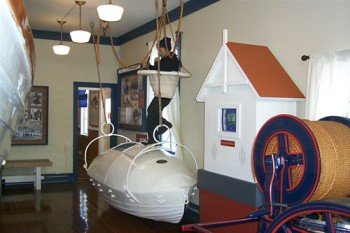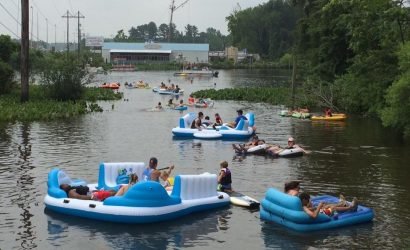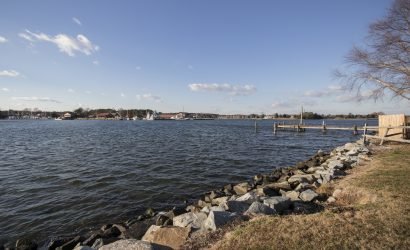This week marked the beginning of the shoulder-season for Ocean City, a time when the summer crowds lessen and the locals venture out to fully enjoy their town once again. In honor of all things local in Ocean City, ShoreBread decided to go Day Trippin’ to the Ocean City Life-Saving Station Museum this week, which is housed in one of Ocean City’s oldest buildings. The Ocean City Life-Saving Station is one of the town’s oldest and most unique structures, having survived relocation from its original location at Caroline Street to the southernmost end of the Boardwalk, where it now operates as a museum.
The first Ocean City Life-Saving Station was built in 1878 and was located on the beach at Caroline Street. One can hardly imagine what the town looked like in 1878, but it is safe to say that it was a far, far cry from what we see today. In fact, in the late 1800’s, housing the life-saving station at Caroline Street was considered to be on the northernmost outskirts of the “village” that was Ocean City. The purpose of the Life-Saving Service, which is essentially a precursor to the Coast Guard, was to prevent ship disasters on the shoals and to provide aide to those who were shipwrecked. According to Ocean City Life-Saving Station Museum Curator Sandy Hurley, the original Life-Saving Service was made up entirely of volunteers, but it wasn’t long before it became apparent that a more organized system was needed.
In 1891, the original station was replaced with a larger structure, the building that now houses the museum. At the time, a local man owned the land where the station stood, leasing it to the town for 100 years for just $1, under the condition that it be used for the Life-Saving Service. Hurley explained that in 1915, the Coast Guard was formed when the Life-Saving Service merged with the Revenue Cutter Service. The building remained in use by the Coast Guard until 1964, when the Coast Guard  built a new building, essentially abandoning the old space. In 1978, when the 100 year lease came to an end, the land reverted back to the owners, who naturally did not want to lease the land again for $1. “In 1975, during the centennial of the Town, the museum society decided to use this building for a museum,” said Hurley. “At the very end of 1977, the town paid to have it moved to where it is now, so now it is a city building on city property. If it wasn’t for Mayor Kelly and the Town Council at that time, the building would have been torn down, which would have been a real shame.”
built a new building, essentially abandoning the old space. In 1978, when the 100 year lease came to an end, the land reverted back to the owners, who naturally did not want to lease the land again for $1. “In 1975, during the centennial of the Town, the museum society decided to use this building for a museum,” said Hurley. “At the very end of 1977, the town paid to have it moved to where it is now, so now it is a city building on city property. If it wasn’t for Mayor Kelly and the Town Council at that time, the building would have been torn down, which would have been a real shame.”
During 19th and 20th centuries, the stations were used primarily for shipwreck rescue and recovery and to spot ships in distress or too close to shore. There were 25 stations along the East Coast, each with red roofs to help make them more visible to sailing ships. The stations housed six to eight surfmen (the crew) along with a Keeper (the man in charge). The keeper had his own quarters, while the men slept in bunks. With most shipwrecks occurring between the months of November to April, the job was fairly seasonal and definitely dangerous. The unofficial motto was, “you have to go out, but you don’t have to come back.”
Today, when you enter the former Life-Saving Station, you are led into the Boat Room, which tells the story of the original Life-Saving Station. Original items such as the surf boat and the throwing gun are situated in the room, along with a collection of artifacts and photos collected over the years. According to Hurley, they maintain one of the most extensive collections of Life-Saving Service artifacts in the country. The artifacts have been accumulated over the last 35 years, with many items coming from local families, and others coming from North Carolina Life-Saving Stations. “It has taken us 35 years, but most everything in here was given to us, so we are very fortunate for that,” said Hurley, noting how generous people have been to donate items, rather than try to sell them elsewhere. As a result, visitors to the museum are able to get a clear depiction of what life must have been like for the surfmen, who were also known as “angels,” “oilskins,” and “storm warriors.”
Also located in the downstairs portion of the museum is the Aquarium Room, which includes local critters and fish, from flounder to blue crab. The Aquarium Room is situated where the kitchen of the station once was. The museum also features three old films, including a film documenting the Great Storm of 1933.
A trip up the steep, old steps to the second floor of the Station House leads to further exhibits, including the most recent addition –Veterans of Worcester County – located in what would have once been the Guest Room. Photos and uniforms are on display, paying homage to Worcester County’s veterans, many of whom still have families that live and work in Ocean City, said Hurley. Adjacent to the Guest Room is the Crew’s Bunkroom, which is now home to the Susan B. Hurley Room, and currently houses the Boardwalk of Yesterday exhibit. Photos of the early days of Trimper’s Rides, antique Boardwalk souvenirs, and antique items such as Laughing Sal fill the room, taking you back to an entirely different life and time along Ocean City’s beloved Boardwalk.
In the Keeper’s Quarters, you’ll find the Surf’s Up exhibit, which is currently enjoying its second year at the museum. The exhibit is dedicated to the evolution of surfing and the surfing community in Ocean City, with photos, memorabilia, and classic surfboards. One of the first surfboards ever built in Ocean City in on display, which is a 1920’s surfboard shaped and built by George Bertrand Cropper.
The Museum is open year round. Hurley explained that while the summer months bring throngs of tourists through the museum, the shoulder season brings many visitors that are eager to peruse the museum with less crowds. Hurley estimated that in a strong year, some 20,000 visitors will pass through their doors.
For a day trip, a few hours in the museum can be paired with any number of activities in downtown Ocean City. September is an ideal month for cruising the boardwalk or taking a bike ride through town, as the crowds have significantly subsided and the weather remains beautiful as ever (fingers crossed). With Sunfest and Bike Week just around the corner, as well as Wine on the Beach at the Inlet parking lot, there are plenty of chances to follow in our footsteps and go Day Trippin’ to the Ocean City Life-Saving Station Museum. Until next time…










